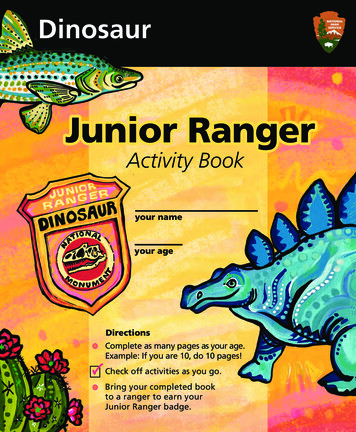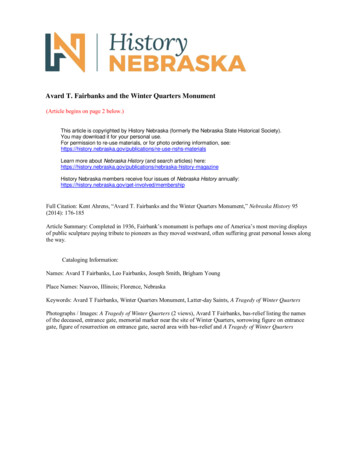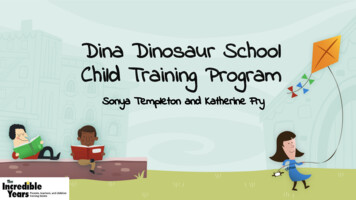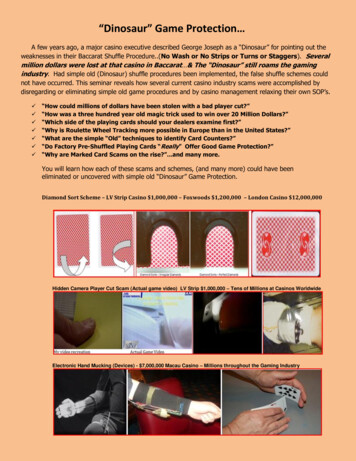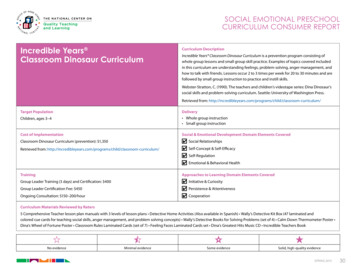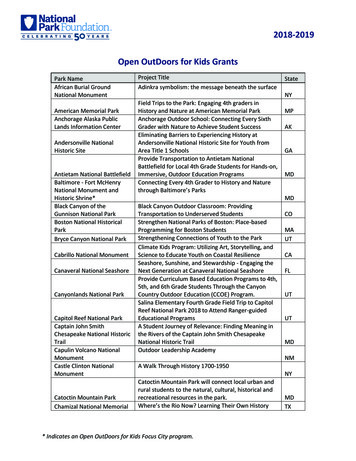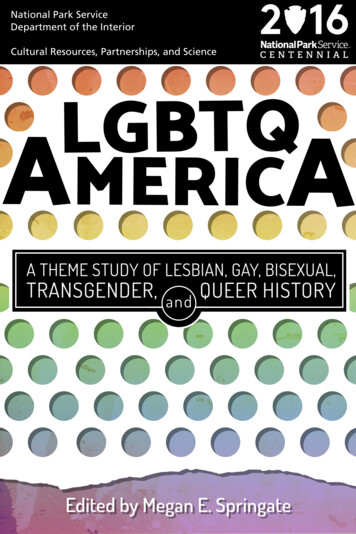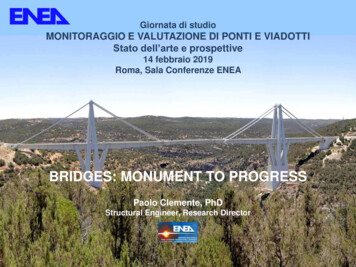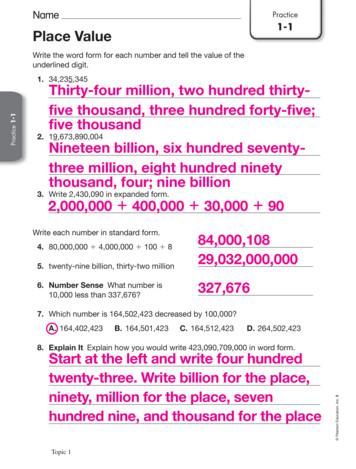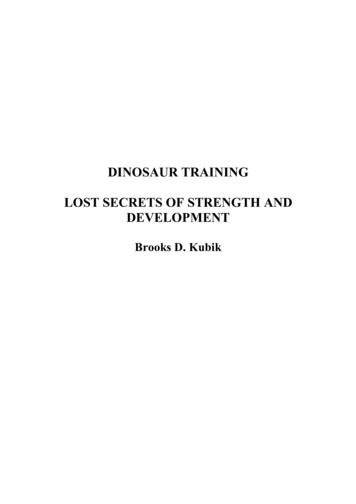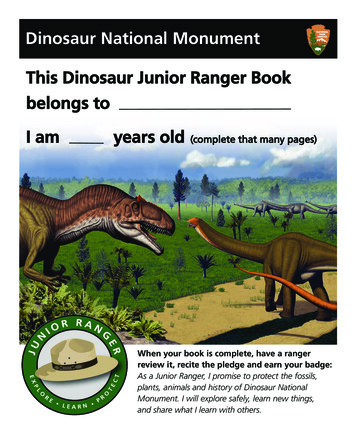
Transcription
Dinosaur National MonumentThis Dinosaur Junior Ranger Bookbelongs toI amyears old(complete that many pages)When your book is complete, have a rangerreview it, recite the pledge and earn your badge:As a Junior Ranger, I promise to protect the fossils,plants, animals and history of Dinosaur NationalMonument. I will explore safely, learn new things,and share what I learn with others.
What Is Important To Protect?Dinosaur National Monument is one of over 400 special places protected bythe National Park Service. The official symbol of the National Park Service (onthe left) and the symbol of Dinosaur National Monument (on the right) havepictures inside that represent important things to protect. Using the NationalPark Service symbol as an example, can you draw lines to match the words to thepictures in the Dinosaur symbol to show what is special and protected here?PlantsHistory &CultureSceneryWaterAnimalsDraw your own symbol for a real or imaginary park:
What Makes Stegosaurus Special?Paleontologists have discovered many dinosaur fossils here. Some of the partslook very strange, especially those from Stegosaurus. You can take your picturenext to the Stegosaurus statue at the Quarry Visitor Center and find real fossilsfrom this dinosaur in the Quarry Exhibit Hall. Study the picture below and thinkof reasons for some of the unusual Stegosaurus body parts.platesspikesStegosaurus had big triangular plates on its back. What could they be for?Why do you think Stegosaurus had spikes on its tail?What clues could tell you if Stegosaurus was a meat eater or a plant eater?What question would you ask Stegosaurus if you had the chance?
Can You Find the Skull?It is rare to find a skull. Skulls are more fragile than other kinds of bones, andthey are not preserved as often as leg bones, ribs and vertebrae. Connect the dotsto find a dinosaur skull among the other bones in the 47152069819161817Bonus: How many skulls did younotice at the Quarry Exhibit Hall?CamarasaurusHint: Some are in cases
How Did the Fossils Get Here?These drawings tell astory about what hashappened here, butthey are out of order!Number the events sothey are in order, startingwith living dinosaurs andending with discovery oftheir fossils.A CeratosaurPaleontologistsneaks up and kills oneof the Camptosaurs.Earl Douglass discoversdinosaur fossils in 1909.A flood buries theAbout 65 millionBacteria and fungicarcass under sand andgravel that protect thebones from scavengers ormore rotting.years ago, the onceflat layers of rock werepushed up, forming anarch called an anticline.cause the soft parts of theCamptosaur carcass torot, returning nutrientsto the soil as it decays.Many layersRain and windof sediment build upand eventually becomesedimentary rock.Minerals enter the bones,turning them into fossils.erode layers of rock fromthe top and sides of theanticline. The layer withthe dinosaur fossils is atthe earth’s surface again.About 150 millionyears ago a group ofCamptosaurs feed onplants along the river.
What Do Dinosaur Names Tell Us?Many names for dinosaurs are made of Greek orLatin words. For example, the word dinosaur comesfrom the Greek word dino, which means terrible, andthe Greek word saurus, which means lizard.Dinosaurs are not actually lizards, they are a group ofreptiles that dominated the land during the Mesozoicera, between 225 and 65 million years ago. Most ofthe dinosaurs found as fossils here lived during theJurassic period, around 150 million years ago.Use words from the list to make up a dinosaur name.What is your imaginary dinosaur name?What does that name mean?acantho spinyallo otherapato deceptiveavis birdbaga littlebaro heavycamara chambercampto flexiblecephalic headceras horncory helmetdino terriblediplo doubledocus beamdryo treegiga savage gianthadro largekentro sharp pointlopho crestnano very smallnodo lumpyodon toothonyx clawpachy thickpedi footsaurus lizardstego rooftorvo savageurus tailxeno strange
Allosaurus means:Apatosaurus means:Barosaurus means:Camarasaurus means:Camptosaurus means:Diplodocus means:Dryosaurus means:Stegosaurus means:Torvosaurus means:Use the list to write the meaning of each name under each dinosaur’s picture.Bonus activity: Can you find each of these dinosaurs in the mural at the QuarryExhibit Hall? Put a star by each dinosaur you find.
Can You Visit Without a Trace?When you visit special places like Dinosaur, every plant, animal, rock andhistoric structure needs to stay in place, just as you found it. Few areas inthe United States still have large areas of wilderness where natural cycles existwithout big changes from human use. Dinosaur is one of those special places.You can help keep wilderness areas wild when you are exploring. Choose theright things to bring, decide what to leave behind, and make good choicesalong the way. Journey through the maze to see how well you can find and followthe Seven Principles of Leave No Trace. (c) Leave No Trace Center for Outdoor Ethics: www.LNT.orgFollowing these 7 Principles of Leave No Trace can help keep Dinosaur wild.Circle the letters to record your choices:Know Before You Go: A or BChoose the Right Path: C or DTrash Your Trash: E or FLeave What You Find: G or H or IBe Careful With Fire: J or KRespect Wildlife: L or MBe Kind to Other Visitors: N or O
Animal Track Match-up (not actual size)Animal feet (and their tracks) come in many different shapes and sizes.Use the descriptions below to identify and label these tracks.FrontBackPrairie DogFrontBackRabbits have small frontfeet and large back feet.When they run, theirback feet land in front.Prairie Dogs are verycommon in this area.Their tracks look likelittle handprints.Bobcats have 4 toe padsand rounded prints.Retractable claws don’tshow up in tracks.Mule Deer have hoovessplit into two parts.Their tracks are almostheart shaped.Coyotes have 4 toe padsand rectangular prints.Their tracks often showclaws marks.Eagles have four toes(3 front, 1 back) and longtalons (claws) that theyuse to catch their food.
What Clues are Found in Animal Tracks?Animals tracks tell a story. Patterns oftracks can show what kind of animalwas there, how fast it moved, and whatdirection it was traveling. A pattern oftracks is called a trackway.What clues in a trackway could tell youif an animal was walking, running, orhopping? Hint: have friends walk, runand jump and imagine the trackwaysthey would leave.Find a trackway (sandy or muddy placesare best) and draw the pattern you see.Write what you think this animal wasdoing. If you can’t find any tracks on theground, use your imagination to draw atrackway and describe it.
What Have You Discovered Here?Do you think of yourself as more of an artist, more of a scientist, or both? Tobe a good scientist, or a good artist, you need to observe the world around youwith as many of your senses as possible. You also need to find ways to share whatyou see, hear, smell and feel with others. Find a place to make some observations.Use pictures or words to describe what you find.
Do Our Decisions Matter?Choices we make todaywill impact the future.In the 1950s, people hadto decide if they wantedto have a dam in partof Dinosaur NationalMonument or not. Thedam would have floodedEcho Park and made partsof the Green and Yampariver canyons into a largereservoir.Echo ParkHumpback ChubRapidCottonwoodThere were many arguments both for and against the dam. Eventually,the choice was made to keep dams out of Echo Park. Use your imagination todescribe how the endangered humpback chub, a whitewater rapid, or a river-sidecottonwood tree might respond to this choice if it could speak for itself:
Who Lived Here First?Dinosaur National Monument has stories of people and different cultures thatEXISTED here for thousands of years. The PALEO Indian culture hunted biganimals 9,000 years ago. When the climate became drier about 6,000 years ago,the Paleo Indians had to change the way they found food. They began to hunt forsmaller animals and started GATHERING seeds, roots and nuts. Desert ARCHAIC isthe name given to this culture.1,000 years ago, a new group of people arrived called the FREMONT. They wereknown for FARMING corn, beans, and squash. The Fremont created many designson the rocks that we can still see today. Rock carvings are called PETROGLYPHSand rock paintings are called pictographs.When European explorers and settlers first entered this area in 1776, it was thehome of the UTE and SHOSHONE. By the 1880s, Utes in this area were forced ontoa RESERVATION. Traditional dances, songs and stories remain an important part ofUte culture NSSEEFARMINGUNARHTEOAIGNANTPETROGLYPHSFind the BOLD WORDS fromabove in the word search.
How Did Pioneers Survive?Homesteading is an important part of the human history in this area.Josie Bassett Morris homesteaded along Cub Creek from 1913 to 1964. Learnmore about Josie by completing the crossword puzzle with these words:pondchickenscubvegetableshiphogsDOWN1. Josie ate well all year longbecause she grew and cannedmany .15. Living alone was risky forJosie. She broke herwhen her horse knocked herdown on frozen ground whenshe was 89 years old.2ACROSS2. The two box canyonsprovided perfect natural corralsfor Josie to raise .3. Creek runs by Josie’shomestead.4. Josie raised many differenttypes of animals includingwhich suppliedher with lots of eggs.6. Water from the Box Canyonspring was captured into a, which served as aswimming hole and storedwater for irrigation.3456
What Can You Find at Dinosaur?There are lots of things to do and see here as a Dinosaur Junior Ranger.The Utah side has tons of cool dinosaur fossils and the Colorado side has wildriver canyons. Plants, animals and many people through time have made theirhomes here. As you explore, circle what you find. Get four in a row for a bingo!Dinosaur SkullJuniper TreeRavenFree Space - DrawYour Own Discovery!Animal TrackRangerMagpieRabbitPetroglyphSteamboat RockBeetleAntDinosaur Leg FossilRiver BoatHomesteadMy favorite thing at Dinosaur National Monument is:Sagebrush
Animals tracks tell a story. Patterns of tracks can show what kind of animal was there, how fast it moved, and what direction it was traveling. A pattern of tracks is called a trackway. What clues in a trackway could tell you if an animal was walking, running, or hopping? Hint: have friends walk, run and jump and imagine the trackways they .
